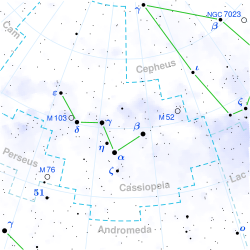Andromedids
| Andromedids | |
|---|---|
|
Radiant of the Andromedids in December 2013 near γ Cassiopeiae (near the middle of the W)
|
|
| Parent body | 3D/Biela |
| Radiant | |
| Constellation | Andromeda |
| Right ascension | 01h 36m |
| Declination | +37° |
| Properties | |
| Occurs during | September 25 – December 6 |
| Date of peak | November 9 |
| Velocity | 19 km/s |
| Zenithal hourly rate | 3 |
The Andromedids meteor shower is associated with Biela's Comet, the showers occurring as Earth passes through old streams left by the comet's tail. The comet was observed to have broken up by 1846; further drift of the pieces by 1852 suggested the moment of breakup was in either 1842 or early 1843, when the comet was near Jupiter. The breakup led to particularly spectacular showers in subsequent cycles (particularly in 1872 and 1885).
In the early 19th century, before the break-up of comet 3D/Biela, the radiant was in Cassiopeia. In the last century the radiant of the modern weaker meteor shower is generally in the constellation of Andromeda as the name of the shower suggests, but due to its age and diffuseness meteors may appear to come from the neighbouring constellations, such as Pisces, Triangulum and Cassiopeia.
The first known sighting of the Andromedids was December 6, 1741, over St Petersburg, Russia. Further strong showers were witnessed in 1798, 1825, 1830, 1838 and 1847. The Andromedids produced spectacular displays of several thousand meteors per hour in 1872 and 1885, as a result of Earth crossing the comet's debris stream. Schmidt, observing from Athens, said that the 1872 shower consisted mainly of faint (5th to 6th magnitude) meteors with "broad and smoke-like" trains and a predominantly orange or reddish colouration. In England, Lowe estimated the same shower as producing at least 58,600 visible meteors between 5.50 and 10.30 pm, observed that the metors were much slower than the Leonids, and noted noises "like very distant gun-shots" several times to the north-west. In Burma, the 1885 shower was perceived as a fateful omen and was indeed followed swiftly by the collapse of the Konbaung dynasty and the conquest by Britain.
...
Wikipedia

